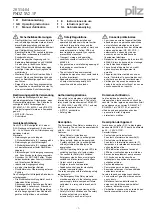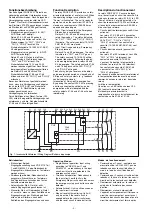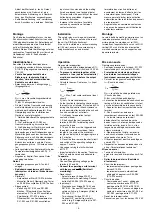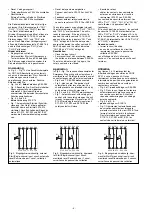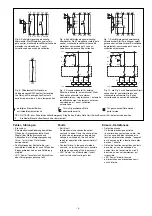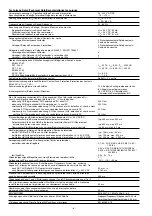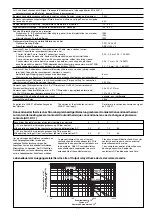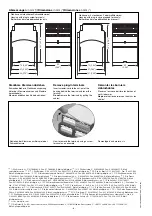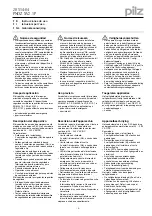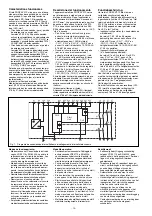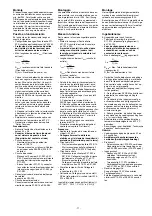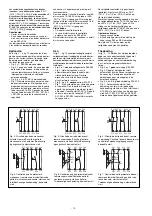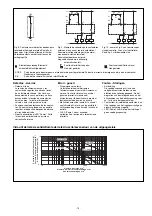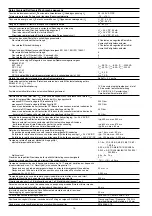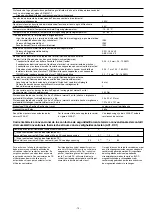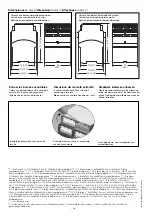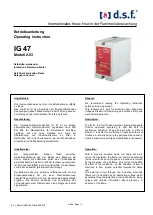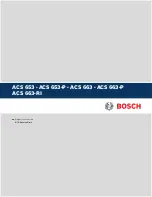
- 4 -
• Reset Verzögerungszeit
Taster oder Brücke an Y39-Y40 anschließen
• Rückführkreis:
Externe Schütze in Reihe zu Startkreis
S13-S14 bzw. S33-S34 anschließen.
Die Sicherheitskontakte sind aktiviert (ge-
schlossen). Die Statusanzeige für "CH.1",
"CH. 2", "CH.1(t)" und "CH.2(t)" leuchten.
Das Gerät ist betriebsbereit.
Wird der Eingangskreis geöffnet, öffnen die
Sicherheitskontakte 13-14/23-24 und die
Statusanzeigen "CH.1" und "CH.2" erlö-
schen. Nach Ablauf der Verzögerungszeit
öffnen die Sicherheitskontakte 37-38/47-48
und die Statusanzeigen "CH.1(t)" und
"CH.2(t)" erlöschen.
Wieder aktivieren:
• Eingangskreis schließen.
• Bei manuellem Start mit Überwachung
Taster zwischen S33 und S34 betätigen.
Die Statusanzeigen leuchten wieder, die
Sicherheitskontakte sind geschlossen.
Anwendung
In Fig. 2 ... Fig. 10 sind Anschlussbeispiele
für NOT-AUS-Beschaltung mit automati-
schem und überwachtem Start, Schutztür-
ansteuerungen sowie Kontakt-
vervielfachung durch externe Schütze.
Bitte beachten Sie:
• Fig. 2 und 7: keine Verbindung S33-S34
• Fig. 2: Beachten Sie: Das Gerät startet bei
Spannungsausfall und -wiederkehr
automatisch. Verhindern Sie einen
unerwarteten Wiederanlauf durch externe
Schaltungsmaßnahmen.
• Fig. 3, 4 und 5, 6:
keine Verbindung S13-S14
• Fig. 7: Automatischer Start bei Schutztür-
steuerung: Das Gerät ist bei geöffneter
Schutztür über den Startkreis S13-S14
startbereit. Nach Schließen der Eingangs-
kreise S11-S12, S21-S22 und S31-S32
werden die Sicherheitskontakte geschlos-
sen.
• Reset delay-on-de-energisation
Connect a button to Y39-Y40 or link Y39-
Y40
• Feedback control loop:
Connect external relays/contactors in
series to reset circuit S13-S14 or S33-S34
The safety contacts are activated (closed).
The status indicators "CH.1","CH.2", "CH.1(t)
and "CH.2(t)" are illuminated. The unit is
ready for operation. If the input circuit is
opened, the safety contacts 13-14/23-24
open and the status indicators "CH.1" and
"CH.2" extinguish. After the delay-on-de-
energisation period the saftey contacts 37-
38/47-48 open and the status indicators
"CH.1(t)2 and "CH.2(t)" extinguish.
Reactivation:
• Close the input circuit.
• For manual reset with monitoring, press
the button and release between S33-S34.
The status indicators light up again, the
safety contacts are closed.
Application
In Fig.2...Fig. 10 are connection examples for
Emergency Stop wiring with automatic and
monitored reset. Safety gate controls as well
as contact expansion via external contactors.
• Fig. 2 and 7: S33-S34 not connected
• Fig. 2, please note: The device starts
automatically after loss of power. You
should prevent an unintended start-up by
using external circuitry measures.
• Fig 3, 4 and 5, 6: S13-S14 not connected
• Fig. 7: Automatic reset with safety gate
control: with the safety gate open the unit
is ready for operation via reset circuit S13-
S14. After closing the safety input circuit
S11-S12, S21-S22 and S31-S32 the
safety contacts will close.
• Boucle de retour:
câbler les contacts des contacteurs
externes en série dans le circuit de
réarmement S13-S14 ou S33-S34
Les contacts de sécurité se ferment. Les
LEDs "CH.1", "CH.2", "CH.1(t)" et "CH.2(t)"
sont allumées. L’appareil est prêt à
fonctionner.
Si le circuit d’entrée est ouvert, les contacts
de sécurité 13-14/23-24 retombent et les
LEDs "CH.1" et "CH.2" s'éteignent. À la fin
de la temporisation, les contacts de sécurité
37-38/47-48 retombent et les LEDs "CH.1(t)"
et "CH.2(t)" s’éteignent.
Remise en route :
• fermer le circuit d’entrée
• en cas de surveillance du circuit de
réarmement, appuyer le poussoir de
validation S33-S34.
Les affichages d'état s'allument à
nouveau. Les contacts de sécurité sont
fermées.
Utilisation
Les figures 2 à 10 représentent les
différents câblages possibles du PNOZ
XV2.1 à savoir: poussoir AU avec
réarmement automatique ou auto-côntrolé,
interrupteurs de position et augmentation du
nombre des contacts de sécurité par
contacteurs externes.
• Fig. 2 et 7: pas de câblage sur S33-S34
• Fig. 2: Dans le cas, l’appareil se réarme
automatiquement après une coupure et
une remise sous tension. Evitez tout
risque de redémarrage par un câblage
externe approprié.
• Fig. 3, 4 et 5, 6:
pas de câblage sur S13-S14
• Fig. 7: Réarmement automatique en cas
de surveillance protecteur: lorsque le
protecteur est ouvert, le circuit S13-S14 se
ferme et le relais est prêt à fonctionner.
Dès la fermeture des canaux d'entrée
S11-S12, S21-S22 et S31-S32, les
contacts de sortie du relais se ferment.
Fig. 4: Eingangskreis zweikanalig, über-
wachter Start/Two-channel input circuit,
monitored reset/Commande par 2 canaux,
surveillance du poussoir de validation
Fig. 3: Eingangskreis einkanalig, überwach-
ter Start/Single-channel input circuit,
monitored reset/Commande par 1 canal,
surveillance du poussoir de validation
Fig. 2: Eingangskreis einkanalig, automat.
Start/Single-channel input circuit, automatic
reset/Commande par 1 canal, validation
automatique
S11 S31
S13
S12
S14
S32
S21
S22
S1
Y39
Y40
S11 S31
S33
S12
S34
S32
S21
S22
S1
S3
Y39
Y40
S21
S11
S33
S22
S34
S12
S1
S3
Y39
Y40
S31
S32

